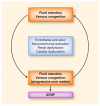Venous congestion and endothelial cell activation in acute decompensated heart failure
- PMID: 20424989
- PMCID: PMC3874714
- DOI: 10.1007/s11897-010-0009-5
Venous congestion and endothelial cell activation in acute decompensated heart failure
Abstract
Despite accumulating clinical evidence supporting a key role for venous congestion in the development of acute decompensated heart failure (ADHF), there remain several gaps in our knowledge of the pathophysiology of ADHF. Specifically, the biomechanically driven effects of venous congestion on the vascular endothelium (the largest endocrine/paracrine organ of the body), on neurohormonal activation, and on renal and cardiac dysfunction remain largely unexplored. We propose that venous congestion is a fundamental, hemodynamic stimulus for vascular inflammation, which plays a key role in the development and possibly the resolution of ADHF through vascular, humoral, renal, and cardiac mechanisms. A better understanding of the role of venous congestion and endothelial activation in the pathophysiology of ADHF may provide a strong rationale for near-future testing of treatment strategies that target biomechanically driven inflammation. Targeting vascular and systemic inflammation before symptoms arise may prevent progression to overt clinical decompensation in the ADHF syndrome.
Figures


References
-
- Lloyd-Jones D, Adams R, Carnethon M, et al. Heart disease and stroke statistics–2009 update: a report from the American Heart Association Statistics Committee and Stroke Statistics Subcommittee. Circulation. 2009;119:480–486. - PubMed
-
- Gheorghiade M, Zannad F, Sopko G, et al. Acute heart failure syndromes: current state and framework for future research. Circulation. 2005;112:3958–3968. - PubMed
-
- Fonarow GC, Heywood JT, Heidenreich PA, et al. Temporal trends in clinical characteristics, treatments, and outcomes for heart failure hospitalizations, 2002 to 2004: findings from Acute Decompensated Heart Failure National Registry (ADHERE) Am Heart J. 2007;153:1021–1028. - PubMed
-
- Yu CM, Wang L, Chau E, et al. Intrathoracic impedance monitoring in patients with heart failure: correlation with fluid status and feasibility of early warning preceding hospitalization. Circulation. 2005;112:841–848. - PubMed
-
- Chaudhry SI, Wang Y, Concato J, et al. Patterns of weight change preceding hospitalization for heart failure. Circulation. 2007;116:1549–1554. - PMC - PubMed
-
This case-control study links increases in body weight, which occur weeks before admission, to hospitalization for heart failure. Close monitoring of body weight identifies a high-risk preadmission period during which new interventions to avert decompensated heart failure are needed.
Publication types
MeSH terms
Grants and funding
LinkOut - more resources
Full Text Sources
Medical

